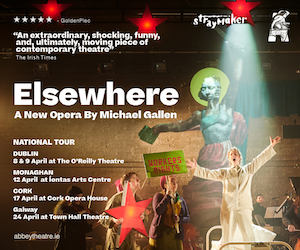
Image taken from the sleeve of Roger Doyle’s Chalant - Memento Mori. Photo: Paula Nolan.
Family Phonography
Roger Doyle: Chalant — Memento Mori. Psychonavigation Records, PSY 052.
The fundamental conceit of Roger Doyle’s Chalant — Memento Mori, as with much of his other work, concerns the bringing together of the musical and the dramatic, the biographical and the sonic, in a context of electronic composition that connects as much with post rock and other popular forms as much it does contemporary ‘academic’ electronic music or sound art.
Exploring Doyle’s ‘cinema for the ear’ principle, as heard in previous works such as the orchestral Adolf Gébler, Clarinettist, Chalant — Memento Mori places answering machine messages from Doyle’s family, friends and collaborators recorded over the period 1987 to 1989, into slow-moving electronic textures, interspersing these powerful but understated sections with instrumental passages dominated by winding, repetitive (digital) piano and zither music.
In making use of voice messages made poignant by the passage of time, and in seeking musically to underline rather than to close down the accrued distance between the time of those messages and our own, these pieces are subtly hauntological — imbued with the spectres of history. The listener is reminded here of Thomas Edison’s ghost(s) in the machine, where the magic and awe of technology facilitates a kind of transcendent experience that can be used to communicate with the dead. More straightforwardly, Chalant connects fruitfully with recent efforts by composers such as John Casken to reinvigorate the melodramatic tradition as a form of spoken words accompanied by music, with the exaggerated emotion traditionally associated with the genre of melodrama removed.
Opening with three instrumental passages, with ciphers of the voice messages teasing the ear here and there, the arpeggios of ‘Chalant: Part 1’ are immediately suggestive of the kind of minor-tinged minimalism found in composers such as Michael Harrison. The following movement replaces this rhythmic directness with ambient but expressive washes of strings. ‘Chalant: Part 3’ has much in common with post rock artists such as Efterklang or Boards of Canada, or even more ambient groups such Stars of the Lid or Loscil, thus invoking one of the more interesting facets of Doyle’s music: its stylistic multiplicity. That multiplicity works more generally to the cycle’s advantage, allowing Doyle to evoke worldly music here, contemporary electronica there, without sacrificing its emotional through-line or stylistic integrity.
‘Voices of Parents RIP’ begins in recent Kate Bush territory, with reverberant piano chords and spare strings arching out plangent sweeps of sound. Messages from Doyle’s now-deceased parents bubble up amidst the sonic fray, before the strings from ‘Chalant: Part 2’ return to bring the section to a dramatically cohesive conclusion. The music is similarly plangent in the following ‘Back in Time’, featuring the voice of Doyle’s then young son Paavo, although the sounds are now more ambient, removed, spectral. Sharing certain musical motifs and emotional gestures, and featuring family members’ voices more singularly than the following sections, these first four tracks effectively serve as an opening suite within the Chalant — Memento Mori cycle.
Having said that, the same whirligig piano arpeggio that features in ‘Chalant: Part 6’ serves as important musical material in the following ‘Coat-hanger Kisses’, which features the voice of (again, now deceased) journalist and broadcaster Jonathan Philbin Bowman. Once again here the emphasis is on a restrained dramatisation, where the patina of time’s distance is subtly underlined by the spacious and eddying music. The voice, here as with the voices in the other sections, is set into a delicate musical texture. The voices are, in fact, rarely foregrounded in the mix, appearing instead as a masked and crumbling part of the dramatic whole. Doyle thus echoes a musician like the Caretaker (a.k.a. James Kirby) and his focus on the sonification of haunting. Chalant, however, is always more directly defined than are the Caretaker’s abstracted sonic canvasses. Doyle’s music favours elegant over uncanny mystery.
Things change tack slightly from this point. ‘Wassane’ is rhythmically forthright and timbrally and tonally pungent, punctuating the foregoing icy, sad beauty with some instrumental bite, albeit relating music-thematically to the opening ‘Chalant: Part 1’. The brief ‘Back from Hospital’ is perhaps the cycle’s brightest moment, whilst the turbulent thwacks and bleeps of ‘It’s Very Serious’ recall some of Scanner’s recent work. I’m not sure how well ‘Ahmad Prelude’ and ‘Ahmad Melodies’, featuring Ahmad Alkaran singing over string pads and quasi–junkyard rhythmic loops, fit thematically with the rest of the cycle, but their vocal rhapsodies at least operate in the same sort of emotional terrain as the surrounding sections.
‘Salomé at the Gate’ makes use of messages from Doyle’s collaborators on that 1988 theatrical production, beginning in major key pianistic territory organised around a shifting rhythmic periodicity which settles, with the introduction of the voices, into a calm processional of piano chords in a five beat cycle, which in turn shifts into the sort of minimalistic solo piano territory explored by Doyle in his music for the play.
The final two sections, ‘Birth’ (featuring text messages between Doyle and Paavo on the birth of the latter’s child), and the stunning valedictory ritualism of ‘Departure’, move more directly back into the sort of revenant subjects and atmospheres as were found in the early sections, bringing the cycle to a dramatically satisfying and — in the final minutes of ‘Departure’ — a richly staged conclusion.
Chalant – Memento Mori represents the straightforward staging of nostalgia as a sufferable tragedy that must be borne by all. It is all the more moving for its understatement, and all the more effective for its flattened treatment of the humorous (evident in the messages from Philbin Bowman and Paavo), the functional (the messages around Salomé) and the quotidian (Doyle’s parents), all of which affects are here submerged in an atmosphere of strange sadness, as if to suggest and in some way to confront the inescapable tragedy that time makes of all our lives.
Published on 25 June 2012
Stephen Graham is a lecturer in music at Goldsmiths, University of London. He blogs at www.robotsdancingalone.wordpress.com.

















